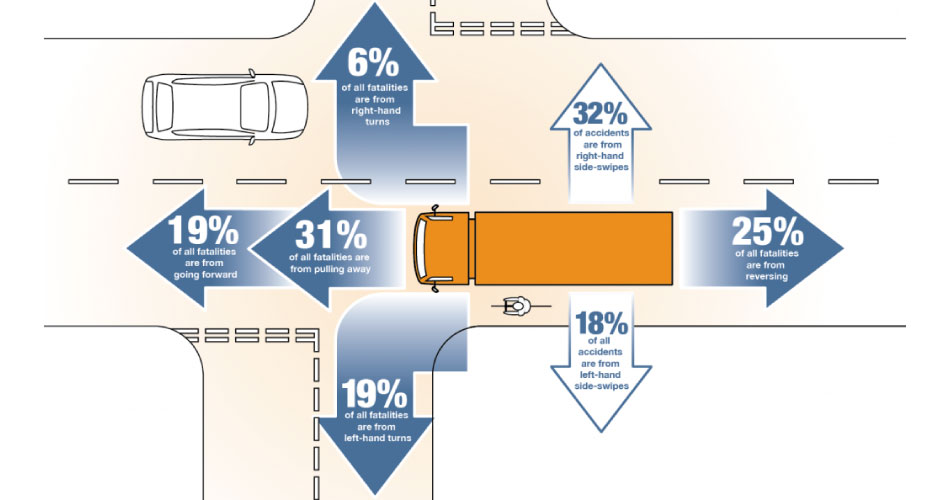THE DANGERS OF BLINDSPOTS
We have all experienced the stress and difficulties of blind-spots when parking, manoeuvring or changing lanes in our cars. It doesn’t take much imagination to appreciate the difficulties commercial vehicle drivers face every day.

Using the Police Accident database this infographic shows where the highest risks of accidents and fatalities are around HGVs and importantly, highlights the dangers of blindspots and lower speed manoeuvres. Fortunately, with today’s technology, blindspots can easily be eliminated.
In the UK 25% of road deaths are caused by reversing vehicles which is a staggering figure when such a small amount of a driver’s time is spent reversing. Research suggests that up to 70% of reversing accidents could be avoided using the right equipment.
In this video, filmed on a budget dashcam (not one of ours) it is clear to see how dangerous lorry blindspots can be. With no visual aids or ultrasonics, it was impossible for the truck driver to know that the blue car was there.
A great deal of attention is now being placed on the dangers of blindspots by trainers and safety schemes such as FORS, CLOCS and Crossrail, and rightly so.
ELIMINATING BLINDSPOTS
When it comes to eliminating blind spots there are a few different options available:
- Fresnel lenses
- Ultrasonics
- Cameras
 FRESNEL LENSES
FRESNEL LENSES
Fresnel Lenses are a visual device for lorry drivers and is not a mirror in the conventional sense. It is a clear thin plastic lens that is press fitted to a lorry window on the near, or passenger side. It’s concentric ring surface allows the driver to see through it directly. However, its optical properties provide a downwards view close to and around the lorry s passenger door. The Fresnel Lens therefore covers the blind spot which frequently is the cause of collisions between lorries and cyclists.

ULTRASONIC SYSTEMS
Ultrasonics, sometimes known as Close Proximity Warning Systems, alert both the lorry driver and the cyclist or pedestrian to the potential danger of a vehicle turning left. When the near side turn indicator is activated, the sensors fitted along the side of the lorry will detect any person or object and alert the lorry driver audibly or visually on a buzzer/display located in the cab. This equipment is ideal as a low speed manoeuvring device on the near side of the lorry in urban areas. An audible alert can also be fitted that works in conjunction with the detection equipment and audibly alerts the cyclist or pedestrian as the vehicle makes a left hand turn.
 CAMERAS
CAMERAS
Described as ‘Indirect Vision Aids’ in the FORS spec, camera systems are perhaps the most obvious solution to eliminating blind spots. Cameras can be placed in strategic locations around the vehicle giving the driver a good view of any troublesome areas when needed via a screen in the cab.
Modern cameras come in all shapes and sizes depending on what they are needed for, they can superimpose guidelines for the driver and can provide a mirror image to ensure the correct orientation of the image.
With varying lens angles and LED night lighting drivers can experience good vision day or night allowing them to spot and avoid obstacles and vulnerable road users. Care should be taken with lens angles of over 150 degrees as the fish-eye effect can distort the image to an unacceptable level.
For more information on using cameras to eliminate blindspots read: “Using cameras to eliminate blindspots”
